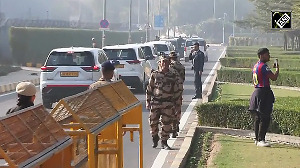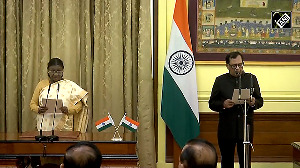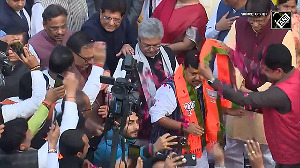Seven months after its launch, India's first moon mission, the Rs 400 crore worth Chandrayaan-1, encountered its first problem on May 16, when its sensors malfunctioned due to thermal radiation from the sun.
The Indian Space Research Organisation, which successfully launched Chandrayaan-1 in October last year, was quick to react and patched Chandrayaan with two sensors in order to steer it.
ISRO chief G Madhavan Nair, while addressing a press conference in Bangalore on Friday, said that there is no cause for concern and the problem has been rectified. The objective of the Chandrayaan is 95 per cent complete and the data required had been collected, he said.
Nair explained that the star sensor, which helps in precision pointing, is used to maneuver the spacecraft. Now since the star sensor has been lost, the spacecraft may not be able to be commanded with the requisite accuracy.
As a result of this, some of the instruments on board the Chandrayaan may not be able to gather all the data, such as the European lunar resources mappers, said Nair.
The resolution of some of the cameras on the Chandrayaan may be compromised and the spacecraft may not be able to give enough return signal strength, he added.
India's first unmanned moon spacecraft was supposed to start relaying data by September.
"Unfortunately, during the last month, we have lost a vital sensor --- the star sensor," Nair said. "Like in the olden days. when one used to look at the stars to fix a direction, likewise an onboard electronic equipment was doing all this and it was required for precise pointing (towards the moon). With its loss we are really worried," he said.
"But to the credit of the ISRO scientific team, they have worked out a very innovative way of overcoming the problem," the ISRO chief said, but added that if some more failures happen, "then we will have problems".
Nair, however, said that in the last eight months of the operation of the mission, "we have collected almost all the data that we wanted" and that most of its objectives have already been completed.
Chandrayaan-I was launched from the spaceport of Sriharikota in Andhra Pradesh on October 22 last year.
Giving details about the problems encountered by the mission after its launch, Nair said "Space missions are very, very complex. There are instances of problems on board. We were also not spared from these."
He said that the craft had faced fairly hostile environment around the moon especially in terms of thermal cycling as well as radiation. "The first thing that we encountered when it was put in the 100 km orbit, it simply reached a stage of thermal runaway. The entire spacecraft would have been baked. We would have lost it," he said, adding that it was a scenario that happened approximately a month after the launch.
The ISRO chief said the mission has reached a stage where many of the electronics have failed and indeed some of the power supply instruments have malfunctioned. "But fortunately, we were able to energise the redundant units and keep them alive all this time. This has been going on for quite sometime. Unfortunately, during the last month, we have lost one vital sensor," he said.
"Chandrayaan can continue but of course one cannot predict....failures can always happen and if some more failures happen, then we have problems," he said, adding that the mission is a "100 per cent success".
On Chandrayaan-II, Nair said the scientists had to take care of environmental issues. "As you know, we did not have any experience of this kind earlier. This is for the first time we have understood the intricacies of going around the moon and this data will help us make the subsequent mission much more reliable," he said.
The mission objectives of Chandrayaan-I included surveying the lunar surface to produce a complete map of its chemical characteristics and three-dimension topography.
Additional Inputs from PTI





